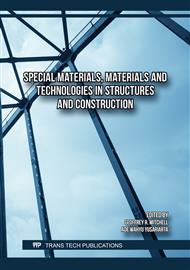[1]
L. Guo, L. Zhang, J. Andersson, O. Ojo, Additive manufacturing of 18% nickel maraging steels: Defect, structure and mechanical properties: A review, Journal of Materials Science & Technology. 120 (2022) 227-252.
DOI: 10.1016/j.jmst.2021.10.056
Google Scholar
[2]
S. Bremen, W. Meiners, A. Diatlov, Selective Laser Melting, laser Technik Journal. 9 (2012) 33-38.
DOI: 10.1002/latj.201290018
Google Scholar
[3]
A. Razavykia, E. Brusa, C. Delprete, R. Yavari, An Overview of Additive Manufacturing Technologies—A Review to Technical Synthesis in Numerical Study of Selective Laser Melting, Materials. 13 (2020) 3895.
DOI: 10.3390/ma13173895
Google Scholar
[4]
E.M. Sefene, State-of-the-art of selective laser melting process: A comprehensive review, Journal of Manufacturing Systems. 63 (2022) 250-274.
DOI: 10.1016/j.jmsy.2022.04.002
Google Scholar
[5]
N. Sanaei, A. Fatemi, Analysis of the effect of internal defects on fatigue performance of additive manufactured metals, Materials Science and Engineering A. 785 (2020) 139385.
DOI: 10.1016/j.msea.2020.139385
Google Scholar
[6]
N. Sanaei, A. Fatemi, Defects in additive manufactured metals and their effect on fatigue performance: A state-of-the-art review, Progress in Materials Science. 117 (2021) 100724.
DOI: 10.1016/j.pmatsci.2020.100724
Google Scholar
[7]
N. Saklakoglu, A. Bolouri, S.G. Irizalp, F. Baris, A. Elmas, Effects of shot peening and artificial surface defects on fatigue properties of 50CrV4 steel, The international Journal of Advanced Manufacturing Technology. 112 (2021) 2961-2970.
DOI: 10.1007/s00170-020-06532-y
Google Scholar
[8]
N. Kalentics, M.O.V. de Seijas, S. Griffiths, C. Leinenbach, R.E. Loge, 3D laser shock peening – A new method for improving fatigue properties of selective laser melted parts, Additive Manufacturing. 33 (2020) 101112.
DOI: 10.1016/j.addma.2020.101112
Google Scholar
[9]
H. Masuo, Y. Tanaka, S. Morokoshi, H. Yagura, T. Uchida, Y. Yamamoto, Y. Murakami, Influence of defects, surface roughness and HIP on the fatigue strength of Ti-6Al-4V manufactured by additive manufacturing, International Journal of Fatigue. 117 (2018) 163-179.
DOI: 10.1016/j.ijfatigue.2018.07.020
Google Scholar
[10]
K. Masaki, Y. Kobayashi, Y. Mizuno, Influence of Shot Peening Treatment on Rotating Bending High-Cycle Fatigue Properties of Additive Manufactured Maraging Steels Material, Journal of the Society of Materials Science of Japan. 67 (2018) 891-897.
DOI: 10.2472/jsms.67.897
Google Scholar
[11]
N.E. Uzan, S. Ramati, R. Shneck, N. Frage, O. Yeheskel, On the effect of shot-peening on fatigue resistance of AlSi10Mg specimens fabricated by additive manufacturing using selective laser melting (AM-SLM), Addititive Manufacturing. 21 (2018) 458-464.
DOI: 10.1016/j.addma.2018.03.030
Google Scholar
[12]
J. Zhang, H. Li, B. Yang, B. Wu, S. Zhu, Fatigue properties and fatigue strength evaluation of railway axle steel: Effect of micro-shot peening and artificial defect, International Journal of Fatigue. 132 (2020) 105379.
DOI: 10.1016/j.ijfatigue.2019.105379
Google Scholar
[13]
J. Wu, H. Liu, P. Wei, C. Zhu, Q. Lin, Effect of shot peening coverage on hardness, residual stress and surface morphology of carburized rollers, Surface and Coatings Technology. 384 (2020) 125273.
DOI: 10.1016/j.surfcoat.2019.125273
Google Scholar
[14]
J. Yasuda, K. Takahashi, H. Okada, Improvement of fatigue limit by shot peening for high-strength steel containing a crack like surface defect—influence of stress ratio, International Journal of Structural Integrity. 5 (2014) 45-59.
DOI: 10.1108/ijsi-07-2013-0012
Google Scholar
[15]
J.C. Newman Jr, I.S. Raju, An empirical stress-intensity factor equation for the surface crack, Engineering Fracture Mechanics. 15 (1981) 185-192.
DOI: 10.1016/0013-7944(81)90116-8
Google Scholar
[16]
American Petroleum Institute, Recommended oractice 579; Fitness for service, C3–C10 (2000).
Google Scholar
[17]
K. Ando, R. Fueki, K.W. Nam, K. Matsui, K. Takahashi, A study on the unification of the threshold stress intensity factor for micro crack growth, Japan Society of Spring Engineers. 64 (2019) 39-44.
DOI: 10.5346/trbane.2019.39
Google Scholar
[18]
K. Ando, M. H. Kim, K. W. Nam, Analysis on peculiar fatigue fracture behaviour of shot peened metal using new threshold stress intensity factor range equation, Fatigue & Fracture of Engineering Materials & Structures. 44 (2021) 306–316.
DOI: 10.1111/ffe.13356
Google Scholar


